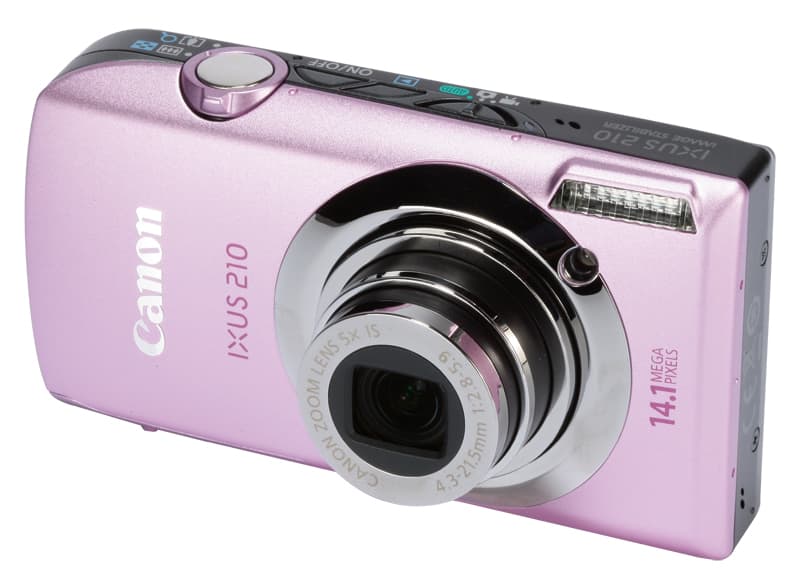Although touchscreen compact cameras aren’t a new idea, advances in touchscreen technology now mean that they are a viable option when it comes to operating the camera easily.
However, I was a little dubious when Canon announced that the 14.1-million-pixel IXUS 210 was going to have no control buttons, and rely instead on a 3.5in touchscreen. In fact, the IXUS 210 has just three buttons and a single switch, all of which are positioned on the camera’s top-plate. The switch changes the camera between its photo, video and automatic modes, while the three buttons function to turn the camera on and off, activate the image playback mode and, of course, operate the camera’s shutter.
Despite the camera lacking the IS (Image Stabilization) suffix, the 24-120mm equivalent lens of the IXUS 210 is stabilised, with Canon claiming that it offers up to a 3EV reduction in the handholdable shutter speed.
The 1/2.3in CCD sensor of the IXUS 210 is the same size as that used in the Digital IXUS 200 IS, yet the IXUS 210 has two million more pixels, with 14.1 million compared to the earlier model’s 12.1 million. With more photosites crammed on to the same small surface area of the sensor, there is always a risk that image noise could become a problem. This could be why the sensitivity has been limited to a reasonably modest ISO 1600.
Performance
 At around the same size as a mobile phone, the IXUS 210 is light and fits comfortably in a trouser pocket. Although the touchscreen is slower to use than buttons, my fears regarding its sensitivity proved unfounded. Only a slight touch is required to press the large virtual buttons, and navigating the settings is simple as Canon has kept the number of options on any one screen to a minimum.
At around the same size as a mobile phone, the IXUS 210 is light and fits comfortably in a trouser pocket. Although the touchscreen is slower to use than buttons, my fears regarding its sensitivity proved unfounded. Only a slight touch is required to press the large virtual buttons, and navigating the settings is simple as Canon has kept the number of options on any one screen to a minimum.
The camera’s touch properties are at their best when using the Touch AF feature. This allows the focus area to be selected by simply touching it on the screen. In face-detection mode, touching a point on the screen enables focus tracking of that object, which is useful for following moving subjects. In all, focusing the IXUS 210 is fast and accurate, particularly in single AF point mode.
There are some interesting Smart Shutter modes on the IXUS 210. The Wink Self-Timer starts the camera’s self-timer once it detects an eye blinking at the camera, which is useful for self-portraits. However, the Smile Shutter is my favourite. When set to this mode, the IXUS 210 automatically takes an image when it detects a smiling face in front of it. I was surprised at just how well this feature works.
With centreweighted and spot metering, as well as EV compensation and ISO sensitivity adjustment, there are plenty of manual-exposure options for those who want more from their compact camera.
For the most part, I found that I used the IXUS 210 in its evaluative metering mode. The results were excellent, with images bright and well exposed. The camera also selected sensible exposure settings when given more awkward backlit scenes. Nearly all the images I took would make good prints without further adjustment.
Colours look bright and natural with the My Colour settings turned off, but with 11 different colour style settings, plus a custom setting, it is possible to achieve most colour effects in-camera. I found the Vivid option to be particularly good for bright and bold holiday snapshots.
Given that the camera’s sensor has 14.1 million pixels, noise is well controlled. When viewing images at 100%, noise is noticeable even at ISO 200, but as most people won’t regularly be making huge prints from a compact camera, it shouldn’t be an issue. In-camera noise reduction causes images to have a smudged effect, especially at ISO 1600, although once again this will only be an issue when making prints at around A4 in size.

Images from the Canon IXUS 210 are well exposed with pleasing colours
Verdict

Despite my anxieties about the touchscreen, the Canon IXUS 210 performed well.
It is slower to use than a model with conventional buttons, but given the point-and-shoot nature of compact cameras, most people won’t change the settings from one shot to the next.
It produces excellent images that are perfect for the casual snapper, while the few manual exposure settings and the stylish design will also appeal to those who demand a little more.
Canon’s IXUS 210 is available in black, silver, gold and pink







